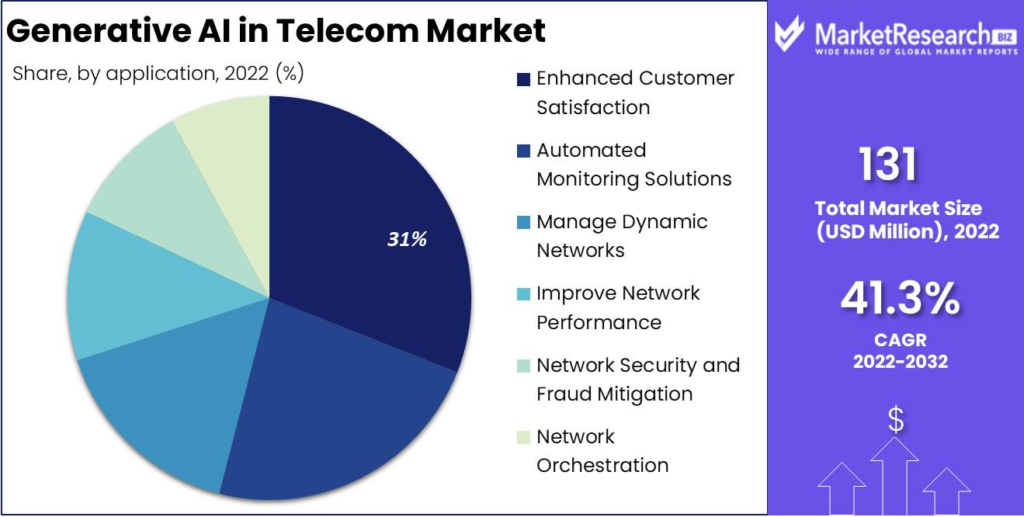Introduction
In the rapidly evolving telecommunications landscape, the integration of Generative AI with Telecom Operational Support Systems (OSS) and Business Support Systems (BSS) is not just an innovation, but also a strategic imperative. As telecom companies grapple with the complexities of 5G deployment, evolving market dynamics, customer needs, and service diversification, the role of AI becomes pivotal. This article delves into the transformative potential of Generative AI aka GenAI in telecom OSS/BSS, offering insights into its impact on efficiency, customer service, and market competitiveness.

The Current State of Telecom OSS/BSS
OSS architecture in telecom is the backbone of telecom industry operations, managing everything from network operations, service provisioning, maintenance, and customer support to billing, revenue management, and customer relationship management. However, traditional systems are often siloed and lack the agility to adapt to the dynamic market demands.
Read also: The Crucial Role of OSS/BSS Testing in Telecom Operations
Integration Challenges
1. Complexity in Operations: With the advent of 5G and IoT, the complexity of network operations has increased manifold.
- Diverse Device Ecosystem: The IoT ecosystem is vast and varied, with a range of devices from simple sensors to sophisticated industrial tools, all requiring seamless network integration.
- Network Slicing: 5G introduces network slicing, which allows operators to create multiple virtual networks on a single physical infrastructure, each slice tailored to specific requirements, adding layers of operational complexity.
- Dynamic Resource Allocation: The need to dynamically allocate resources in real-time to different services and customers further complicates operations.
2. Customer Demand for Personalization: Customers now demand highly personalized services, quick resolutions, and seamless experiences.
- Customized Service Expectations: Customers expect services tailored to their unique needs, whether it’s customized data plans or personalized content.
- Real-Time Engagement: The demand for real-time engagement through various channels has increased, with customers expecting instant responses to inquiries and support requests.
- Integrated Experience across Devices: As customers use an array of devices, they expect a consistent and integrated service experience across all touchpoints.
3. Need for Speed and Efficiency: The market pressure to reduce operational costs while speeding up service delivery is intense.
- Rapid Service Deployment: The market demands rapid deployment of new services to keep pace with evolving technologies and customer expectations.
- Cost-Effective Scaling: Telecom operators must scale their services cost-effectively to accommodate the exponential growth in data traffic and connected devices.
- Energy Efficiency: With the growing focus on sustainability, telcos are also expected to reduce their energy consumption despite increasing operational demands.
4. Market domination: The telecom industry finds itself struggling when it comes to deliver enhanced customer and market domination.
5. Regulatory Compliance: Telecoms must navigate a complex web of regulations that vary by region and are constantly evolving, especially concerning data privacy and security.
6. Cybersecurity Threats: The expansion of network infrastructure and services also expands the attack surface for cybersecurity threats, requiring robust security measures integrated into telecom OSS/BSS solutions.
7. Skill Gaps: There is a growing skill gap as the need for expertise in managing advanced telecom systems and AI integration increases.
8. Interoperability Issues: Ensuring interoperability between legacy systems and new technologies remains a significant hurdle for many operators.
The Role of Generative AI in Telecom OSS Architecture
The telecommunications industry stands on the brink of a new era, where Generative AI is playing a transformative role. By integrating with Telecom Operational Support Systems (OSS) and Business Support Systems (BSS), AI is breaking down the long-standing barriers between these two pillars of telecom operations, enabling a more cohesive and agile approach to managing services and customer relationships. This section explores the multifaceted role of Generative AI in revolutionizing telecom OSS architecture and telecom BSS solutions.
Did you know?
Telcos that have integrated AI report an average increase in efficiency of 40% and a reduction in operational costs by 30%.
Enhancing Decision-Making with Predictive Analytics
Generative AI excels in identifying and learning from patterns within large datasets, which is instrumental in predictive analytics. Here’s how it’s changing the game:
- Proactive Network Maintenance: AI algorithms can forecast potential network disruptions by analyzing historical data, leading to preemptive maintenance and reduced downtime.
- Churn Prediction: By understanding customer behavior, AI can identify warning signs of churn, allowing telecoms to intervene with retention strategies before a customer departs.
Read also: Why Telecom Customers Leave?
Automation of Routine Tasks
The automation capabilities of AI free up valuable human resources.
- Process Automation: Repetitive tasks such as data entry, billing operations, and status reports are being automated, leading to increased efficiency and accuracy.
- Customer Service: AI chatbots and virtual assistants can handle routine customer inquiries and troubleshooting, providing 24/7 support without human intervention.
- Enhanced Service Provisioning: Automated processes enable quicker service rollouts and better resource management.
Case Study Download: See how Avisys Services Revolutionized Provisioning for Saudi Telecom Giant
Use-Cases
Network Optimization: AI-driven telecom OSS solutions are transforming network management.
- Intelligent Traffic Management: AI systems manage data flow efficiently, reducing congestion and ensuring optimal network performance.
- Resource Allocation: Generative AI can simulate and predict the best strategies for resource allocation, considering the ever-changing network demands.
Personalized Marketing Campaigns
Telecom BSS solution, when integrated with AI, offers unprecedented marketing capabilities:
- Behavioral Targeting: AI analyzes customer usage patterns to tailor marketing efforts, ensuring higher conversion rates.
- Dynamic Pricing Models: AI can adjust pricing in real-time based on market demand, customer profiles, and consumption patterns.
Service Design and Innovation
Generative AI can also play a crucial role in service design and innovation.
- New Product Development: AI can help in designing new products by simulating customer reactions to different features and pricing models.
- Service Customization: AI enables the creation of customizable service packages and tariff plans that adapt to individual user needs and preferences.
Enhancing Customer Experiences
Generative AI’s ability to process and analyze customer data enhances user experiences.
- Predictive Personalization: AI anticipates customer needs and provides personalized recommendations for services and content.
- Quality of Service (QoS) Adjustments: AI dynamically adjusts QoS for individual customers based on their current activity and service level agreements.
The Strategic Impact of AI on Telecom
Generative AI is not just an operational tool; it’s a game-changer for telecom companies, offering new avenues for growth and transformation.
- Innovation in Service Offerings: AI enables the creation of new, cutting-edge services that can differentiate a telco in the market.
- Agility in Market Response: AI’s predictive capabilities allow for faster adaptation to market changes and customer needs.
- Disaster Recovery: AI can predict outage patterns and automate recovery processes, minimizing downtime.
- Fraud Detection: Advanced AI algorithms can detect and prevent fraudulent activities in real-time.
The Future is Now! Embracing AI in Telecom
For forward-thinking telecom organizations, the question is not if but when and how to integrate Generative AI with Telecom OSS/BSS.
Steps to Integration
- Assessment of Current Systems: Evaluate your current telecom OSS/BSS landscape and identify areas for AI integration.
- Pilot Projects: Start with AI pilot projects to demonstrate value and build a case for wider implementation.
- Skilling and Culture: Invest in AI skills development and foster a culture of innovation within the organization.
- Employ Agile POD & COE: Invest in agile POD engagement and COE for your telecom company to leverage the best of AI and agile technologies for your telco.
Takeaway
The integration of Generative AI with Telecom OSS/BSS is more than a technological upgrade; it’s a strategic shift that will define the future of telecommunications. By embracing AI, telecom companies can not only streamline their operations but also unlock new opportunities for innovation and growth. The time to act is now, with the potential for AI to deliver tangible benefits across the spectrum of telecom operations, from network management to customer engagement and beyond.
The integration of Generative AI into Telecom OSS/BSS represents a significant leap forward for the industry. By enhancing decision-making, automating routine tasks, and providing real-world applications for network optimization and personalized experiences, AI is setting the stage for a more efficient, customer-centric, and innovative future in telecom. As the industry continues to evolve, the role of AI will undoubtedly expand, offering new opportunities for telecom operators to grow and thrive in an increasingly connected world.
For telecom leaders, the path forward is clear. Act now or perish later!
Ready to transform your telecom operations with Generative AI? Join the AI revolution for telecom with Avisys Services.



